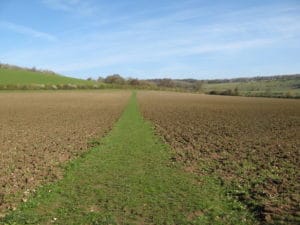Support us from £3/month
We deal with almost 1000 cases a year assisting communities, groups and individuals in protecting their local spaces and paths in all parts of England and Wales. Can you help us by joining as a member?
We have called for public access to form a core component of future agricultural support.
Responding to Defra’s Environmental Land Management policy discussion document, the society says that ‘the public must be able to see, enjoy and learn from what is achieved with spending raised from their taxes.’ It has proposed that public spending on agriculture should bring: ‘more and enhanced access for the public, in extent, character and equality.’

Uncultivated path across ploughed field in Turville, Bucks. We are supporting incentives for leaving cross-field paths undisturbed like this one
The discussion document sets out Defra’s initial thinking for ELM scheme design and invites comments on high-level design options. The society commends this ‘opportunity to integrate better access provision with wider environmental benefits’. It suggests that access routes can also be corridors for hedgerow planting, flood defences can also double as walking, horse riding and cycling facilities and provide excellent level access for those with impaired mobility.
Hugh Craddock, one of our case officers, has called on Defra to make access options compulsory in scheme tiers 1 and 3. He comments: ‘We have proposed that land managers in tier 1, the entry level, should be required to keep cross-field public paths uncultivated and green byways rolled and mown—and be rewarded for their efforts. But this should not be optional—it should be an obligatory part of every agreement.’
The society has proposed that tier 2 agreements, the mid-level tier, should reward new access, either along defined paths or ‘freedom to roam’. Hugh adds: ‘There is huge opportunity to improve access under tier 2. We’ve highlighted how new access should promote embrace all recreational users—for example, new paths for horse riders and cyclists; easy-access paths for those with limited mobility; wide, easy-to-use paths for family visits; educational access for schools; access to high land for hang- and para-gliders; and access to riverside for families, swimmers and unpowered craft.’
And in the landscape-scale tier 3, we have said that new and better access should be a convincing and fundamental part of every proposal. The public should be given an opportunity to learn what is being done, and why, at first hand—for example, a long-distance multi-user trail, combining the best of existing rights of way and new paths, will help show off the project to local people and visitors and promote healthy recreation.
Better access provision will demand advisers who are skilled and experienced in access provision. Hugh adds that: ‘Too often, access has been a bolt-on to existing agreements with little public benefit. We are calling for access to be integral to future agreements, and for knowledgeable advisers enthusiastically to encourage land managers to provide a step-change in the quality, quantity and longevity of public access provision.’
Our response is here.
